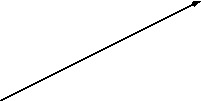| [ << ] | [ < ] | [ Up ] | [ > ] | [ >> ] | [Top] | [Contents] | [Index] | [ ? ] |
3.3 Figure size
In Asymptote, coordinates like (0,0) and (100,100),
called pairs,
are expressed in PostScript "big points" (1 bp = 1/72
inch) and the default line width is 0.5bp.
However, it is often inconvenient to work directly in
PostScript coordinates.
The next example produces identical output to the previous example, by
scaling the line (0,0)--(1,1) to fit a rectangle of width
100.5 bp and height 100.5 bp (the extra 0.5bp
accounts for the line width):
size(100.5,100.5); draw((0,0)--(1,1));

One can also specify the size in pt (1 pt = 1/72.27 inch),
cm, mm, or inches.
Two nonzero size arguments (or a single size argument) restrict the
size in both directions, preserving the aspect ratio.
If 0 is given as a size argument, no restriction is made in that direction;
the overall scaling will be determined by the other direction (see size):
size(0,100.5); draw((0,0)--(2,1),Arrow);

To connect several points and create a cyclic path, use the
cycle keyword:
size(3cm); draw((0,0)--(1,0)--(1,1)--(0,1)--cycle);

For convenience, the path (0,0)--(1,0)--(1,1)--(0,1)--cycle
may be replaced with the predefined variable
unitsquare, or equivalently, box((0,0),(1,1)).
To make the user coordinates represent multiples of exactly 1cm:
unitsize(1cm); draw(unitsquare);
| [ << ] | [ < ] | [ Up ] | [ > ] | [ >> ] | [Top] | [Contents] | [Index] | [ ? ] |
This document was generated on May 24, 2014 using texi2html 5.0.
